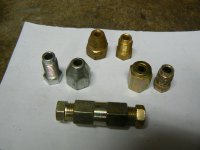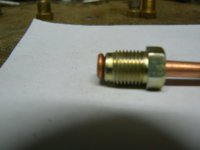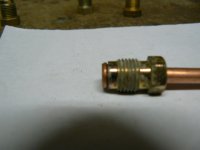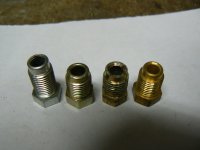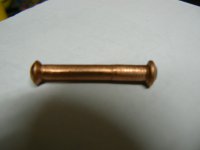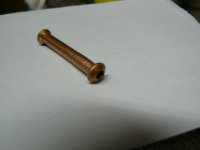Corroded brake pipes. failed MOT. B****r! A load of hassle isn't it? So, unless it's a one off, just make your own. There's a big choice of tools to fit all pockets. Can I say this is not intended as a guide to making your own pipes but rather an entertainment for you on my gear. If you have a go at it you must take great care - faulty brakes are lethal!
A good place to start is with deciding on what pipe to use. Most DIY grade flaring tools will not satisfactorily flare steel! This actually isn't too much of a problem because high quality copper pipe is readily available and is used in many commercial establishments. Copper though has two weaknesses. It is soft (that's good because it makes it easy to work) but it is prone to sagging on long runs so may need extra brackets to support it. Also it work hardens. This second property means it's banned in many countries - but not here - an immediate problem this causes is that you must only bend it once, don't try to straighten it if you get your bend wrong (unless you anneal it) but, more insidiously, people worry it may crack or fracture due to vibration and flexing on the vehicle. I used to worry about this but don't now because I have never seen this problem and have never talked to another mechanic who has. (bear in mind the pipes must be supported properly as when the original was fitted. The problem with sagging on long runs I overcome by using Kunifer (Cupro Nickel) pipe. It resists corrosion very well but is stiffer than pure copper so behaves much more like steel. The Kunifer also has a much higher recommended max pressure compared to the copper 214 bar compared to 127 bar. but 127 bar is still far in excess of anything you can create in a normal braking system. Here's some images of pipe, and a packet of tube nuts, as you buy them from the factor:
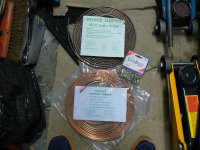
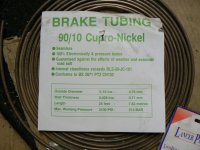
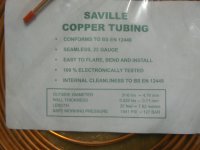
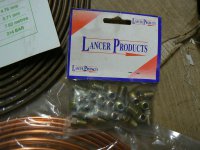
All the local garages seem to use copper now a days and it causes some hilarity when I ask for the Kunifer.
Once you've carefully measure the length of pipe needed (do this carefully to get a neat result) it's got to be cut from the roll. a mini pipe cutter like this makes life easy.
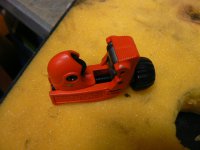
It cuts the pipe nice and square and slightly bevels the outer edges. You should carefully clean out the burrs from the inside of the cut too if you want your forming tool to last. If you cut the pipe with a mini hacksaw you must square off and deburr carefully. I also slaister silicon grease on the end of the die too.
So now to my tools. Shortly after leaving college, back in the late '60's I bought this:
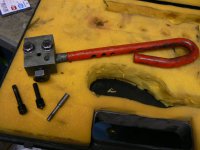
Here it is with the die head split. You can see the shape of the die which forms the back of the flare. When the other half of the die is assembled it grips the pipe firmly. A forcing bolt, which has the shaping die inserted though it, screws into the other side. The forcing bolt is tightened firmly and the flare is formed.
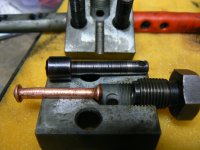
Here it is with the shaping die in place
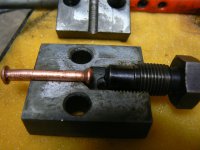
Here are the two dies which form the end shape. No1 (convex, some say "single" flare) on the left, No2 (concave, come say "double" flare) in the middle. The piece on the right is a stop piece to set the correct pipe depth for flaring.
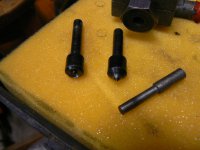
Many years later I bought this tool as I understood that it produced a more "square backed" flare - more like the metric shape.
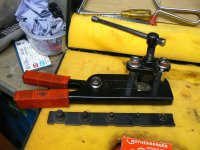
It works well enough but isn't any better than my original tool. There is one thing I don't particularly like about it though. My old tool keeps it's die straight by having a long tang on the forming die (which goes through the forcing screw) This tool does it by having a long, and much less substantial, tang on the end of the forming die which actually enters the bore of the pipe.
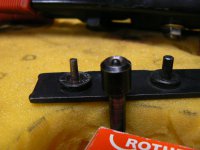
This tang, you can see it here compared to the old tool's die, tends to get crushed and held by the pipe as the flare is formed. sometimes, especially with kunifer which takes more force to form, I worry it's going to break as I try to withdraw the die from the end of the tube. Also the instructions which come with the tool say to set the pipe level with the face of the tool to allow for the correct "crush" I find that to form a robust flare you need to double this height. When you do this you can only just get the forcing screw to swing round over the die.
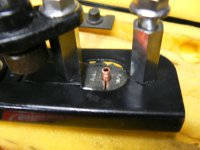
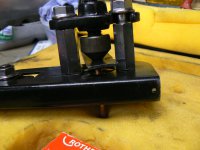
So there you are. My tools and experiences, for what they're worth. I do prefer my "old friend" from all those years ago. we've spent many "happy" hours together under a wide variety of motors, with me inventing new and obscene ways to swear at stubborn brake pipes! He's very "honest" too, as he only ever claimed to be able to "do" one size of pipe. The "young pretender" makes promises he can't possibly keep:
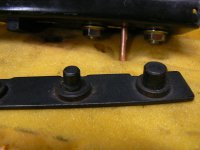
I don't think so chum! Oh, just a parting thought, Don't forget to put your tube nuts on - right way round - before you flare the other end of the tube will you!


